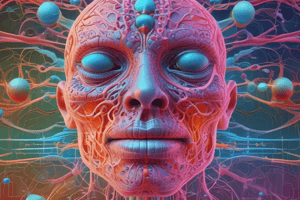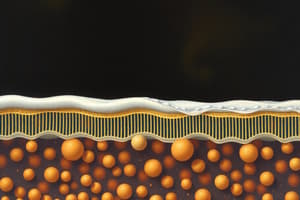Podcast
Questions and Answers
What is the primary focus of body mechanics?
What is the primary focus of body mechanics?
- Improving mental health through physical activity
- Study of body movements and mechanical principles (correct)
- Understanding the biochemical processes within cells
- Enhancing body strength through nutrition
Which of the following processes is NOT involved in maintaining homeostasis?
Which of the following processes is NOT involved in maintaining homeostasis?
- Excretion
- Social interaction (correct)
- Circulation
- Respiration
What is the role of tissues in the human body?
What is the role of tissues in the human body?
- Absorbing oxygen for respiration
- Storing genetic information
- Regulating metabolism
- Composing the different organ systems (correct)
Regular physical activity can help prevent which of the following health issues?
Regular physical activity can help prevent which of the following health issues?
Which principle is not a focus of biomechanics?
Which principle is not a focus of biomechanics?
Which factor does NOT play a significant role in body stability during movement?
Which factor does NOT play a significant role in body stability during movement?
What impact does physical activity have on cardiovascular function?
What impact does physical activity have on cardiovascular function?
Which system is primarily responsible for nutrient distribution throughout the body?
Which system is primarily responsible for nutrient distribution throughout the body?
Flashcards are hidden until you start studying
Study Notes
Kriya Shareera Study Notes
Body Mechanics
- Definition: Study of body movements and mechanical principles.
- Focus on:
- Posture: Alignment of body segments to minimize strain.
- Stability: Maintaining balance during movement.
- Efficiency: Using minimal energy for maximum movement.
- Key concepts:
- Leverage: Use of body levers to enhance strength and performance.
- Force: Application of physical power to create movement.
- Gravity: Influence on body dynamics and posture.
Physiological Processes
- Overview: Functions that sustain life and maintain homeostasis.
- Key processes:
- Respiration: Gas exchange and oxygen supply.
- Circulation: Blood flow and nutrient distribution.
- Digestion: Breakdown of food for energy and nourishment.
- Excretion: Removal of waste products from the body.
- Impact of physical activity on these processes:
- Improved cardiovascular function.
- Enhanced metabolism.
- Increased respiratory efficiency.
Anatomy Of The Body
- Basic structure:
- Organs: Functional units (e.g., heart, lungs, liver).
- Tissues: Groups of cells (e.g., muscle, connective, epithelial).
- Systems: Organ systems (e.g., muscular, skeletal, nervous).
- Importance of understanding anatomy:
- Foundation for diagnosing and treating injuries.
- Insight into how different body parts interact during movement.
Impact Of Movement On Health
- Benefits of regular physical activity:
- Weight management: Balancing calories and energy expenditure.
- Disease prevention: Reducing risk of chronic diseases (e.g., diabetes, heart disease).
- Mental health: Alleviating symptoms of anxiety and depression.
- Mobility: Enhancing flexibility, strength, and endurance.
- Sedentary lifestyle risks:
- Increased risk of obesity.
- Poor cardiovascular health.
- Musculoskeletal disorders.
Biomechanics
- Definition: Study of the mechanical laws relating to movement or structure of living organisms.
- Key principles:
- Kinematics: Describes motion (e.g., velocity, displacement).
- Kinetics: Examines forces causing movements (e.g., torque, friction).
- Applications:
- Sports: Optimizing performance and reducing injury risks.
- Rehabilitation: Designing effective treatment plans and exercises.
- Ergonomics: Enhancing workplace efficiency and comfort.
Body Mechanics
- Explores body movements through mechanical principles to understand efficiency and stability.
- Posture minimizes strain by ensuring proper alignment of body segments.
- Stability is crucial for maintaining balance during various activities.
- Emphasizes Efficiency in movement by utilizing minimal energy for optimal performance.
- Leverage involves using body levers to amplify strength and enhance performance.
- Force is the application of physical energy to trigger movement.
- Gravity significantly affects body dynamics and overall posture, influencing movements.
Physiological Processes
- Encapsulates the functions necessary for sustaining life and achieving homeostasis.
- Respiration facilitates gas exchange, ensuring a steady supply of oxygen.
- Circulation encompasses blood flow, distributing nutrients throughout the body.
- Digestion involves breaking down food into usable energy and nourishment.
- Excretion is vital for the elimination of waste products from the body.
- Regular physical activity positively modifies these processes by improving cardiovascular function and enhancing overall metabolic rates.
Anatomy Of The Body
- Comprised of Organs, which serve as functional units (e.g., heart, lungs).
- Tissues are categorized into groups of cells, including muscle, connective, and epithelial types.
- Organ systems like muscular, skeletal, and nervous systems illustrate how various organs function collectively.
- Knowledge of anatomy provides a basis for diagnosing injuries and understanding the interactions between different body parts during movement.
Impact Of Movement On Health
- Engaging in regular physical activity aids in Weight Management by balancing calorie intake with energy used.
- Supports Disease Prevention by reducing the risk of chronic illnesses such as diabetes and heart disease.
- Contributes to better Mental Health and can alleviate symptoms of anxiety and depression.
- Enhances Mobility, improving flexibility, strength, and endurance over time.
- Risks associated with a Sedentary Lifestyle include increased obesity rates and poor cardiovascular health leading to musculoskeletal disorders.
Biomechanics
- Defined as the study of mechanical laws related to the movement and structure of living organisms.
- Kinematics focuses on the description of motion, including aspects like velocity and displacement.
- Kinetics investigates the forces that cause movements, such as torque and friction.
- Applications of biomechanics extend to:
- Sports for optimizing athlete performance and minimizing injury risks.
- Rehabilitation to formulate effective treatment strategies and exercises for recovery.
- Ergonomics, which aims to improve workplace efficiency and comfort by understanding body mechanics.
Studying That Suits You
Use AI to generate personalized quizzes and flashcards to suit your learning preferences.




